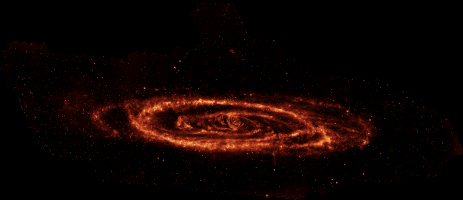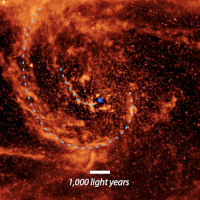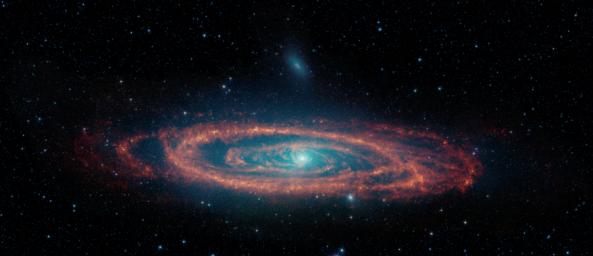
Figure A

Figure B
Click on images for larger versionsThis image from NASA's retired Spitzer Space Telescope highlights the stars and dust clouds in the Andromeda galaxy. One of Earth's nearest galactic neighbors, Andromeda spans a swath of sky nearly 3.8 degrees across, which is close to the width of eight full Moons lined up side by side. The area around the galaxy includes data from NASA's Wide-field Infrared Survey Explorer (WISE).
Spitzer observed infrared light, a range of wavelengths longer than what human eyes can detect. In this image, starlight glows blue and cyan (representing infrared wavelengths of 3.6 and 4.5 microns). Dust dominates the galaxy in red (8 microns). The longest wavelength detected by Spitzer (24 microns) gives an indication of the dust's temperature and is represented in green; it combines with the red to create orange and yellow, indicating regions where stars are forming.
Figure A shows only the dust, making it easier to see a large dust ring around the Andromeda galaxy's center. While both the Milky Way and Andromeda are spiral galaxies, the Milky Way's dust structure is slightly different, with distinct spiral arms stretching out from the galaxy's center. The images also revealed a secondary hole in one portion of Andromeda ring where a dwarf galaxy passed through.
Figure B, also taken from Spitzer data, is an annotated, close-up view of the dust near the center of the Andromeda galaxy. Blue dotted lines highlight the path of two dust streams flowing toward the supermassive black hole at the galaxy's center (indicated by a purple dot).
NASA's Jet Propulsion Laboratory managed the Spitzer Space Telescope mission for the agency's Science Mission Directorate in Washington until the mission was retired in January 2020. Science operations were conducted at the Spitzer Science Center at Caltech. Spacecraft operations were based at Lockheed Martin Space in Littleton, Colorado. Data are archived at the Infrared Science Archive operated by IPAC at Caltech. Caltech manages JPL for NASA.
For more information about Spitzer, visit: https://www.nasa.gov/spitzer

 Planetary Data System
Planetary Data System














